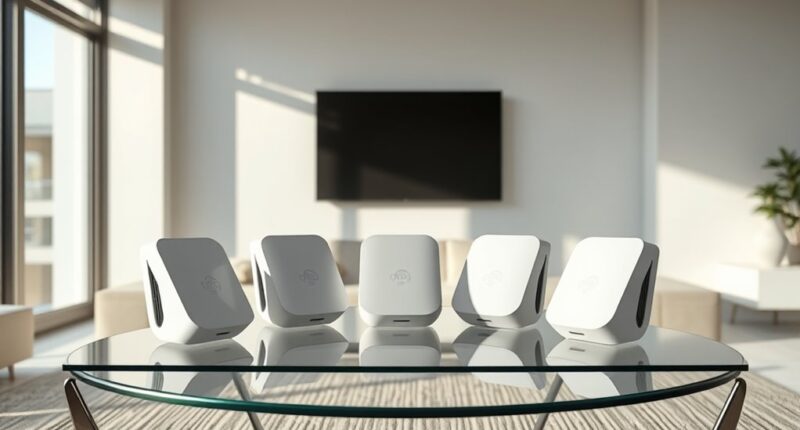If you’re after seamless connectivity in 2025, I recommend checking out the top mesh WiFi systems like the eero, TP-Link Deco AX3000, NETGEAR Orbi, and Deco XE75. These systems support the latest WiFi 6 and 6E standards, handle numerous devices, and offer strong security features. They’re easy to set up and perfect for large homes or smart setups. If you want all the details, keep exploring to find the best fit for your needs.
Key Takeaways
- Compatibility with existing internet providers and support for over 150 devices ensures broad device integration.
- WiFi 6/6E support and multi-gigabit ports deliver high-speed, reliable performance for demanding activities.
- Built-in security features like WPA3, parental controls, and regular updates protect your network and privacy.
- User-friendly mobile apps and plug-and-play setup make installation quick and accessible for all users.
- Prioritizing device support, speed, security, and easy setup ensures seamless, stable home connectivity.
Like-New Amazon eero mesh WiFi router
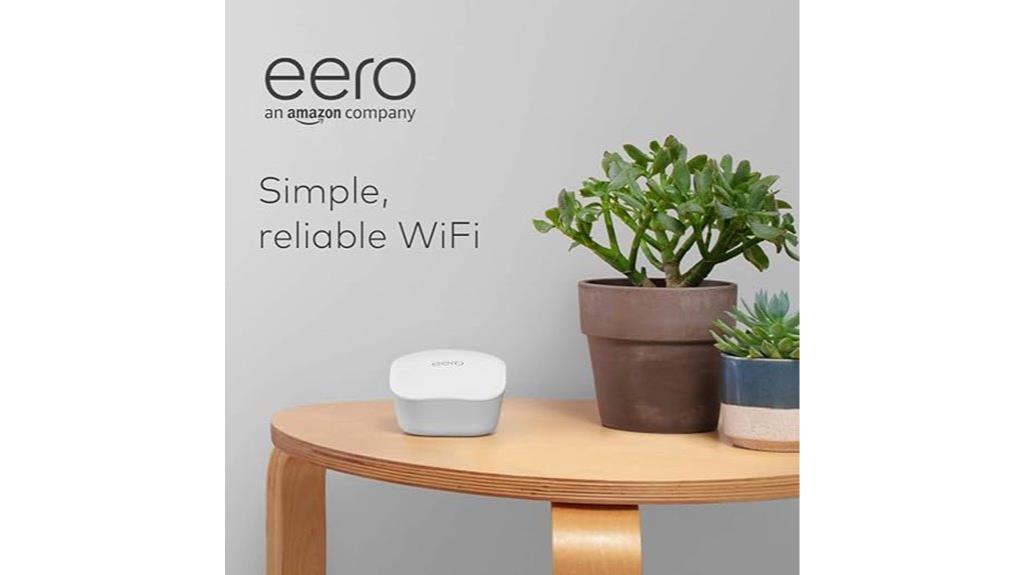
If you’re looking for a reliable, like-new mesh WiFi solution, the Amazon eero router is an excellent choice. This refurbished device is tested and certified to look and work like new, backed by the same limited warranty as a brand-new product. It provides fast, dependable WiFi coverage of up to 1,500 sq. ft., perfect for streaming, gaming, or working from home. Easy to set up in under 10 minutes using the eero app, it also seamlessly integrates with Alexa for voice control. Plus, you can expand your system effortlessly with compatible eero hardware, ensuring reliable connectivity as your needs grow.
Best For: those seeking a reliable, easy-to-set-up mesh WiFi system for streaming, gaming, and working from home in a medium-sized home.
Pros:
- Fast and dependable WiFi coverage up to 1,500 sq. ft.
- Easy setup in less than 10 minutes with the eero app.
- Compatible with Alexa for voice-controlled management and smart home integration.
Cons:
- Limited coverage if used as a standalone router in very large homes.
- Requires an existing internet service provider and modem for setup.
- May need additional eero units to expand coverage significantly in larger spaces.
TP-Link Deco AX3000 WiFi 6 Mesh System (Deco X55)
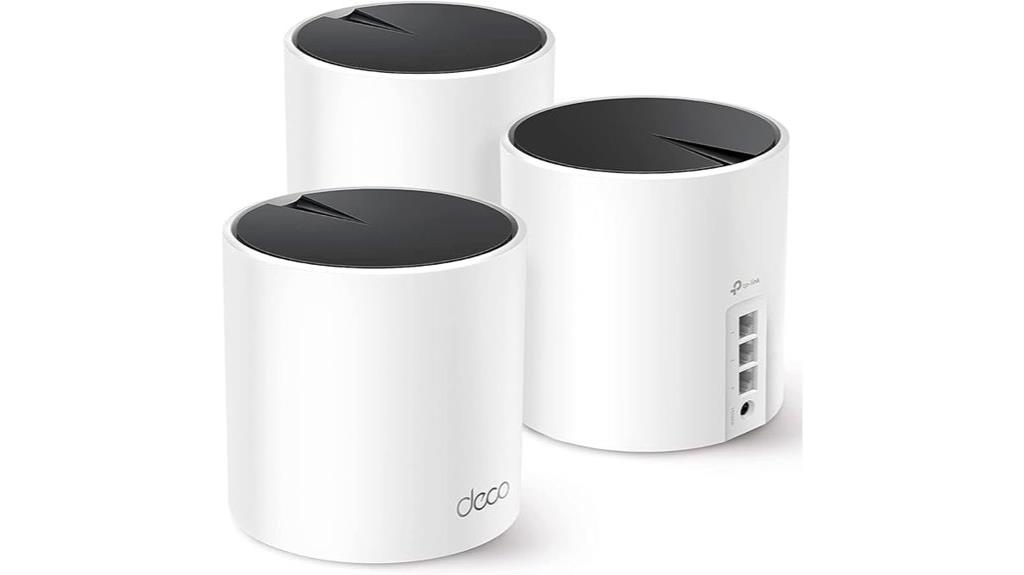
The TP-Link Deco AX3000 WiFi 6 Mesh System (Deco X55) is an excellent choice for large households or users with demanding internet needs, thanks to its extensive coverage of up to 6,500 square feet and support for over 150 devices simultaneously. It replaces traditional routers and extenders, delivering seamless whole-home Wi-Fi with speeds up to 2.4 Gbps. Its AI-driven mesh technology optimizes network performance, while easy setup via the Deco app makes management simple. Each unit includes three Gigabit Ethernet ports for wired backhaul, ensuring stable connections. Overall, the Deco X55 offers fast, reliable Wi-Fi, ideal for busy homes and high-bandwidth activities.
Best For: households or users with large homes and high internet demands seeking reliable, seamless Wi-Fi coverage for numerous devices.
Pros:
- Extensive coverage up to 6,500 sq.ft. and support for over 150 devices simultaneously
- Supports Wi-Fi 6 with fast speeds up to 2.4 Gbps for demanding activities
- Easy setup via the Deco app with management options for remote control and optimization
Cons:
- Requires proper placement and line of sight for outdoor units to maximize performance
- Occasional disconnections or red lights may require manual rebooting for stability
- Wired outdoor units via PoE switches are recommended for best speeds, adding complexity for outdoor installation
NETGEAR Orbi Mesh WiFi 6 System (RBK853)
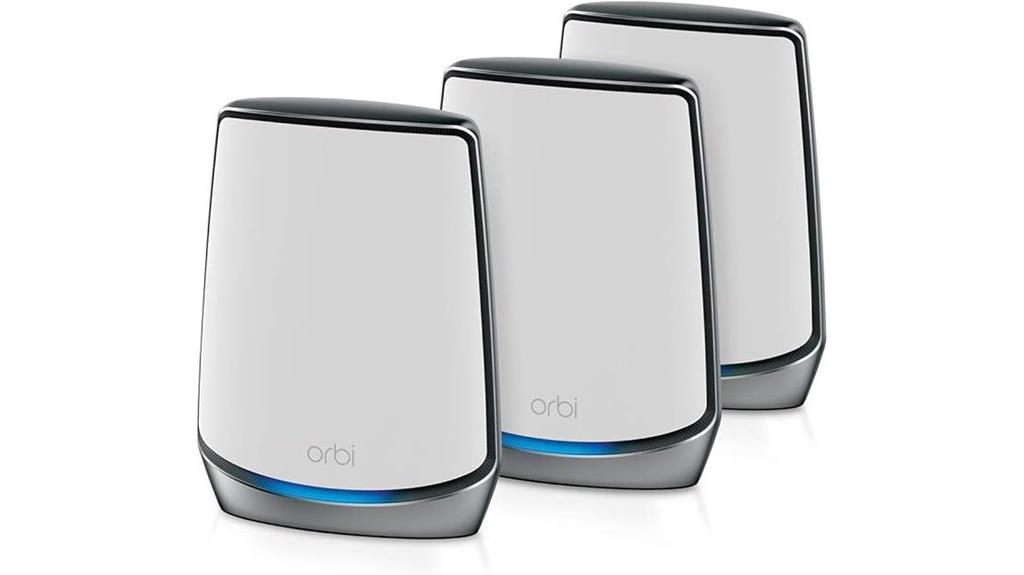
Designed for large homes and demanding environments, the NETGEAR Orbi Mesh WiFi 6 System (RBK853) offers extensive coverage up to 7,500 square feet and supports up to 100 devices simultaneously. It features AX6000 gigabit WiFi 6 technology, delivering speeds up to 2.5 Gbps, perfect for streaming, gaming, and smart home setups. The system includes a router and two satellites, each with Ethernet ports for wired connections, and additional satellites extend coverage further. Easy to set up via the Orbi app, it provides reliable, high-speed connections across multiple floors. While some users report occasional instability, overall, it’s an excellent choice for large, device-heavy homes.
Best For: large households with extensive device networks seeking high-speed, reliable WiFi coverage with advanced security features.
Pros:
- Extensive coverage up to 7,500 sq. ft. and support for up to 100 devices
- Fast AX6000 gigabit WiFi 6 speeds up to 2.5 Gbps, ideal for streaming and gaming
- Easy setup and management through the user-friendly Orbi app
Cons:
- Some users experience system instability, reboots, and connectivity drops
- Higher price point compared to other mesh systems, which may not suit smaller households
- Occasional compatibility issues with regional power standards and smart home devices
TP-Link Deco AX3000 WiFi 6 Mesh System (Deco X55)
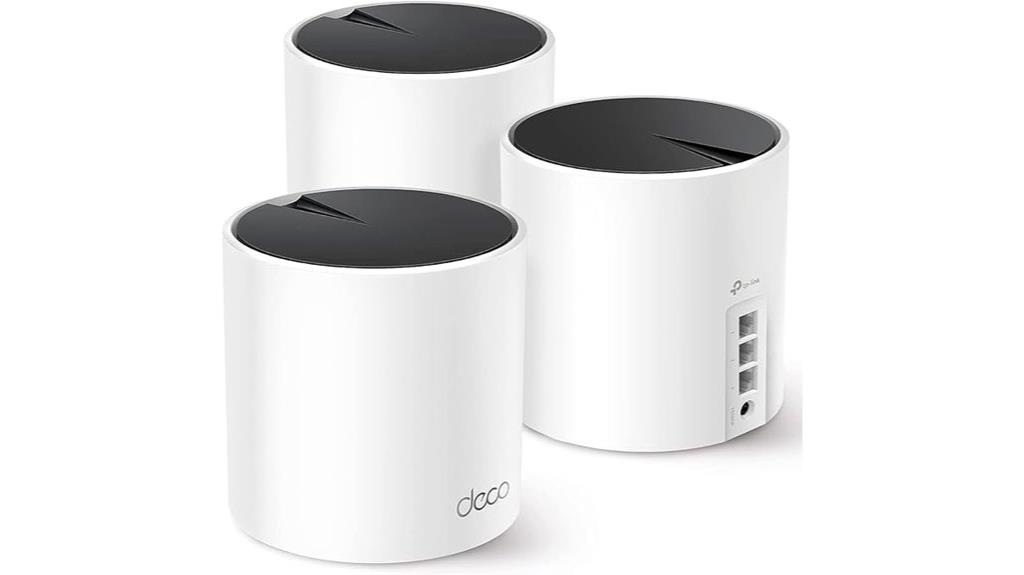
For homeowners seeking reliable, high-speed Wi-Fi coverage over large areas, the TP-Link Deco AX3000 WiFi 6 Mesh System (Deco X55) stands out as an excellent choice. Covering up to 6,500 sq.ft., it replaces traditional routers and extenders with seamless mesh technology. Supporting Wi-Fi 6 speeds up to 2.4 Gbps, it handles over 150 devices simultaneously with ease. Easy to set up via the Deco app, it offers robust security, reliable outdoor performance, and wired backhaul options with Gigabit ports. Its upgraded speed and stability make it ideal for large homes, streaming, gaming, and smart home device management.
Best For: homeowners with large properties seeking reliable, high-speed Wi-Fi coverage and seamless connectivity for multiple devices.
Pros:
- Covers up to 6,500 sq.ft. with seamless mesh coverage, eliminating dead zones
- Supports Wi-Fi 6 speeds up to 2.4 Gbps and over 150 connected devices simultaneously
- Easy setup via the Deco app with management and security features included
Cons:
- External outdoor units require hardwiring via PoE switches for optimal performance
- Occasional issues like red lights or temporary disconnections may require manual rebooting
- Performance outdoors can be affected by line of sight and obstructions, needing proper placement
TP-Link Deco XE75 AXE5400 Tri-Band WiFi 6E Mesh System

If you need a reliable, high-speed mesh WiFi system capable of covering large homes, the TP-Link Deco XE75 AXE5400 Tri-Band WiFi 6E Mesh System stands out in 2025. It covers up to 7,200 sq.ft and replaces routers and extenders with AI-driven mesh technology for seamless connectivity. With WiFi 6E tri-band speeds up to 5,400 Mbps, it supports over 200 devices efficiently, even on multiple levels. Setup is quick via the Deco app, and the system offers industry-rated support with a 2-year warranty. Its secure, user-friendly design guarantees reliable performance for streaming, smart home devices, and busy households.
Best For: households requiring reliable, high-speed WiFi coverage across large, multi-level homes with many devices.
Pros:
- Covers up to 7,200 sq.ft with seamless mesh connectivity
- Supports WiFi 6E tri-band speeds up to 5,400 Mbps for over 200 devices
- Easy setup via the Deco app with industry-rated support and warranty
Cons:
- Some smart devices may not support the 6 GHz band yet
- Larger power adapters and short power cords can be inconvenient
- Limited web management options, primarily app-based control
Factors to Consider When Choosing Mesh Wifi Systems
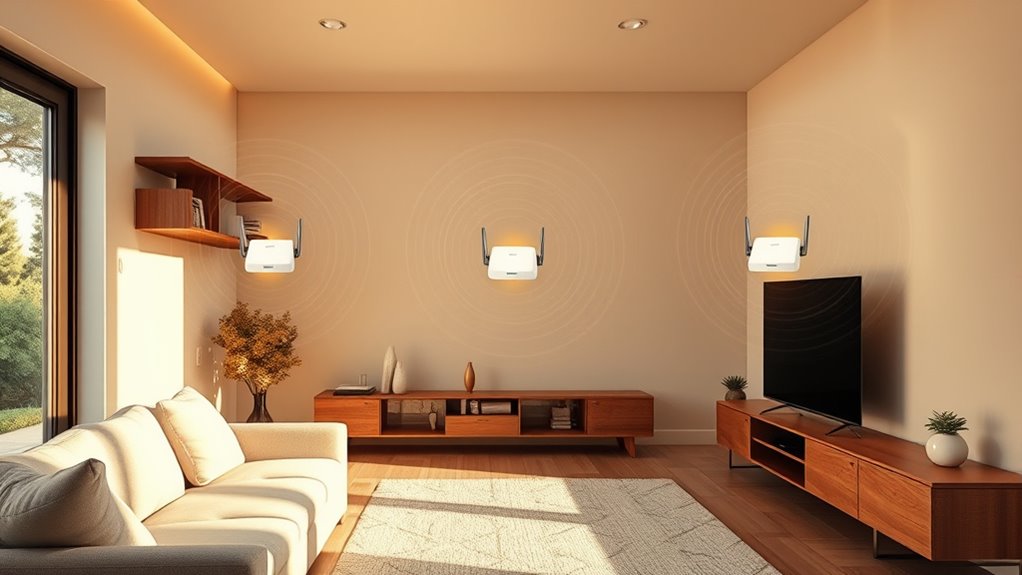
When choosing a mesh WiFi system, I focus on several key factors to get the best fit for my needs. I consider the coverage area, device compatibility, and the speeds required for smooth streaming and gaming. Security features and setup ease also play a big role in making my decision simpler and more secure.
Coverage Area Needs
Choosing the right mesh WiFi system starts with understanding the size of the area you need to cover. Mesh systems vary from supporting just a few hundred to over 7,000 square feet, so knowing your space is vital. Larger homes or multi-story buildings often need multiple nodes to guarantee strong, consistent coverage across all levels. External outdoor units can extend WiFi further, but they require clear line-of-sight and proper placement. Additionally, consider how many devices will connect simultaneously, as more devices demand broader or more powerful coverage. Planning for future expansion is also wise—many systems allow you to add nodes later if your needs grow. Evaluating your space and potential growth helps you choose a mesh system that remains reliable long-term.
Device Compatibility
Selecting a mesh WiFi system requires guaranteeing compatibility with your existing devices and network setup. First, check that it works with your internet service provider and supports your current modem or gateway. If you have many devices, look for a system that can handle over 150 simultaneously connected gadgets, ideal for large households. Compatibility with smart home devices and voice assistants like Alexa or Google Assistant is also vital for seamless integration. Additionally, verify that the system supports the WiFi standards you need, such as WiFi 5, WiFi 6, or WiFi 6E, for peak performance. Finally, review the system’s app or management platform to guarantee it provides easy setup and control for all your devices. Compatibility is key to a smooth, hassle-free experience.
Speed Requirements
To make certain your mesh WiFi system keeps up with your internet needs, it’s essential to take into account speed requirements carefully. If you have high-speed internet or plan to upgrade to gigabit plans, look for systems supporting Wi-Fi 6 or Wi-Fi 6E, which maximize throughput and minimize lag. Wi-Fi 5 simply can’t deliver the speeds demanded by demanding activities like 4K streaming or online gaming. For ultra-fast connections over 1 Gbps, choose a mesh system with multi-gigabit ports that support multi-gig internet plans. Additionally, if you have many devices—over 150 connected simultaneously—you’ll need higher bandwidth capabilities to maintain smooth performance. For seamless streaming, gaming, or large file transfers, aim for a system with at least 2.4 Gbps total speed.
Security Features
As internet speeds increase and more devices connect to your network, security becomes a top priority when evaluating mesh WiFi systems. I look for systems with built-in security features like WPA3 encryption and automatic firmware updates to keep vulnerabilities at bay. Advanced options like parental controls, guest network isolation, and device access management help protect against unauthorized access. Systems with integrated security suites, such as anti-malware and intrusion detection, offer extensive protection for all connected devices. Regular security patches from manufacturers ensure the system stays resilient against evolving threats. Additionally, features like VPN support and IoT device segmentation can further enhance privacy and reduce security risks within your home network. Prioritizing these features helps me stay safe online without sacrificing convenience.
Setup Simplicity
When choosing a mesh WiFi system, setup simplicity is crucial to guarantee a smooth installation process. I look for systems with dedicated mobile apps that offer step-by-step visual guides, often completed in under 30 minutes. Devices supporting quick setup features, like plug-and-play installation, make the process straightforward, even with minimal technical skills. Wired backhaul options can also simplify setup by reducing wireless interference and boosting stability during configuration. User-friendly systems typically include auto-detection and automatic network optimization, which streamline initial deployment. Clear instructions and minimal hardware components are also signs of an easy-to-install system. Overall, a hassle-free setup ensures I get connected quickly without frustration, making the entire experience more enjoyable.
Frequently Asked Questions
How Do Mesh Wifi Systems Improve Network Coverage Compared to Traditional Routers?
You’re wondering how mesh WiFi systems boost network coverage compared to traditional routers. I’ve found that mesh systems use multiple nodes to create a seamless network, eliminating dead zones and providing consistent coverage throughout your home. Unlike single routers, they automatically route data through the best path, which reduces congestion and improves speed. This setup makes it easier for me to connect multiple devices without losing signal strength or experiencing lag.
Can Mesh Wifi Systems Support Multiple Simultaneous High-Bandwidth Devices Effectively?
You’re wondering if mesh WiFi systems can handle multiple high-bandwidth devices at once. I’ve found that modern mesh systems are designed to support several devices simultaneously without sacrificing speed or stability. They intelligently manage traffic, ensuring each device gets enough bandwidth. So, whether you’re streaming, gaming, or working from home, a good mesh WiFi system can keep everything running smoothly and seamlessly.
Are Mesh Wifi Systems Easily Expandable With Additional Nodes?
Think of mesh WiFi systems as a living, breathing web that grows effortlessly. Yes, they’re easily expandable with additional nodes, like adding new branches to a thriving tree. I’ve found that most systems are designed for smooth integration, allowing you to extend coverage without hassle. Just plug in a new node, and it seamlessly joins the network, ensuring your connection stays strong and reliable as your home or office expands.
What Security Features Should I Look for in a Mesh Wifi System?
When choosing a mesh WiFi system, I look for strong security features like WPA3 encryption, which protects my network from unauthorized access. I also prefer systems with automatic firmware updates to patch vulnerabilities, built-in firewalls, and parental controls for added safety. Additionally, advanced features like device isolation and VPN support give me peace of mind knowing my network stays secure and private.
How Do Firmware Updates Affect Mesh Wifi System Performance and Security?
I know firmware updates might seem like a hassle, but they’re essential for your mesh WiFi system’s performance and security. When I update mine, I notice my connection gets smoother, and any vulnerabilities are patched. Skipping updates can leave you exposed to security threats and slow speeds. So, I make sure to keep my firmware current—it’s a simple step that keeps my network fast and safe.
Conclusion
Choosing the right mesh WiFi system isn’t just about speed or coverage—it’s about creating a reliable, seamless experience that feels almost invisible. Like a fine symphony, each component must work in harmony, yet stand out when needed. As you weigh your options, remember that the best system balances power and simplicity, ensuring your connected world flows effortlessly. After all, in the dance of technology and daily life, harmony makes all the difference.

